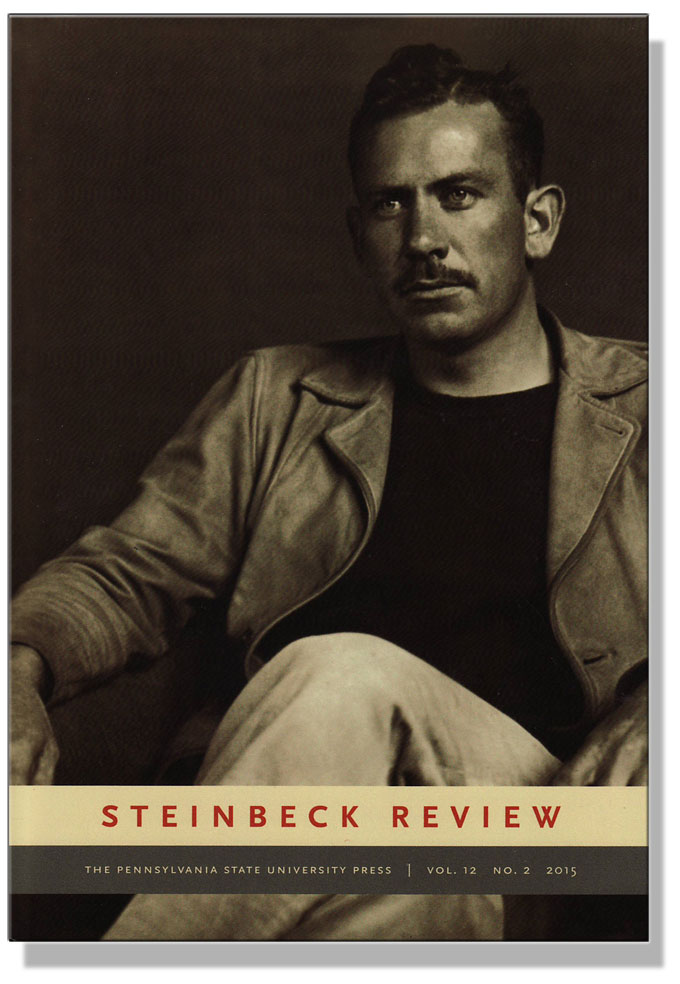Who said literary criticism is just for critics? Not the editors of Steinbeck Review. The winter 2015 issue proves that San Jose State University, the journal’s publisher, embraces diversity in many forms, and that its editors are willing to let non-critics play the specialist’s game. Among the current contributors are (1) a graduate student in history from Canada, (2) a former college film teacher, (3) a retired biology professor and dean living in Oregon, (4) a Steinbeck fan from California’s Central Valley, and (5) the W.W. Kellogg Professor of Agriculture, Food and Community Ethics at Michigan State University. But the unlikeliest candidate in the intriguing mix may be Daniel Levin, a pharmaceutical research executive with a Ph.D. in chemistry from Cambridge University who now lives in California. Prompted by a visit to the National Steinbeck Center and curious about apparent discrepancies between an exhibit there and Steinbeck’s Hebrew in East of Eden, Levin took a scientific approach, consulting Talmudic sources, Steinbeck curators, and a Hebrew language adviser to investigate Steinbeck’s adaptation of the term timshol from the Genesis story about Cain’s banishment, east of Eden, after he kills his brother Abel. “John Steinbeck and the Missing Kamatz in East of Eden: How Steinbeck Found a Hebrew Word but Muddled Some Vowels,” the result of Levin’s exemplary study, demonstrates why, for lovers of John Steinbeck, literary criticism is too important to be left to professional literary critics. See for yourself. Subscribe to Steinbeck Review.
Trackbacks
-
[…] Steinbeck’s discussion of the Hebrew word “timshel” in East of Eden fascinated me as a metaphor for our choice in how and whether to response to evil, and I was moved to look up the passage in the Hebrew Bible that contained the word—from the story of Cain and Abel—that Steinbeck quotes. When I discovered that Steinbeck had incorrectly transliterated the Hebrew word timshol, I consulted Hebrew and other sources about its meaning and Steinbeck’s use. My research was eventually published in an article by Steinbeck Review, as reported in a post at SteinbeckNow.com. […]
-
[…] and other experts around the world. It led to a report on my findings in a paper published in the winter 2015 issue of Steinbeck Review, and to my presentation during the Jewish festival of […]



I think this edition of the Steinbeck Review is outstanding in its diversity and freshness in interpretations of John Steinbeck and the world in which he lived and wrote. The Daniel Levin article, “John Steinbeck and the Missing Kamatz in East of Eden: How Steinbeck Found a Hebrew Word but Muddled Some Vowels,” brought back memories of the first descriptive writer who influenced my own writing and thinking: Harry Golden, a North Carolinian who published a monthly newspaper called “The Carolina Israelite” and wrote several books about Jews in America, two of which are “Only in America” (a 1958 national bestseller) and “For 2¢ Plain.” Kimberly Hartnett wrote an excellent interpretation of Golden’s work in “Carolina Israelite: How Harry Golden made us care about Jews, the South and Civil Rights.”
Golden was a great storyteller, and one of his stories led me to the concept of a gathering place where informal talk manages relations within informal networks. The gathering place later became a major concept in my interpretation of John Steinbeck as the first social ecologist. Doc’s Lab was through Steinbeck’s lens the important gathering place on Cannery Row, one which influenced the world through Steinbeck and thinkers like Joseph Campbell, the mythologist who was part of the lab group in 1932.
The story: Harry smoked five cigars a day. He would buy them one at a time at the corner vendor which sold newspapers, had a coffee bar, and featured a cross-section of Charlotte society passing through the store daily. A different crowd would be there depending on the time of day, and an acquaintance noted that Golden went out five times a day to get one cigar. He suggested to Golden that he could pick up his five cigars in one trip, saving him five trips from his second floor office. Golden’s response was: ” My dear friend, you miss the point of my five trips. They are just not to buy cigars but to see and hear what is going on in Charlotte.” The gathering place in my social ecology theory work was born from that story, and as I became familiar with Steinbeck it was enhanced by my reading of “Tortilla Flat,” “Cannery Row,” “Sweet Thursday,” “The Grapes of Wrath” (the federal camp) and other writing.
So thank you editors and contributors to this issue of Steinbeck Review. It took me back to an important time of discovery in my life and career.
Jim Kent is the author of a SteinbeckNow.com blog post that asks the question, “Was John Steinbeck the first social ecologist?”